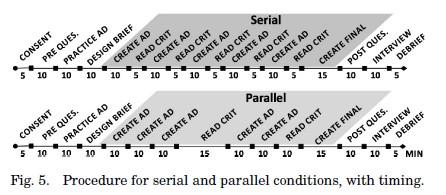First a definition: “Parallel Prototyping” is where multiple design concepts are evaluated before beginning an iterative design process.
There are two different flavors of parallel prototyping (or parallel design):
- Several designers each create one or more designs, then the entire group considers all concepts. The best ideas are cherry picked to create one or more improved designs.
- One designer creates multiple designs, then all designs are critiqued and the designer creates revised designs.
Contrasting the parallel process is the serial process: only one design concept is ever really considered. This one design is repeatedly critiqued and revised.
A study by Steven Dow et al* from Stanford in late 2010 compared the parallel and serial prototyping processes (using the one designer, multiple designs method).
In both the parallel and serial conditions, subjects created 5 prototype ads, then a final ad. They received a critique on each prototype. Subjects were given equal time to create each prototype and to review each critique. But the process varied:
- Serial Process: Subjects received critiques after creating each prototype.
- Parallel Process: Subjects created 3 prototypes, then received critiques on all 3. Next they created 2 more prototypes and received feedback again before creating a final ad design.
The following graphics explain the processes:

The Results
There were three major findings.
1. Quality of Designs
The parallel design process yielded better-performing designs (as measured both by expert critiques and click-through performance).
2. Design Diversity
The parallel process generated more diverse designs. (No surprise here: a serial process implicitly encourages refinement of a single idea.)
3. “Self-Efficacy” and Reactions to Critiques
This is the most interesting finding. Parallel participants reported an increase in task-specific self-efficacy (task-oriented confidence). Serial participants did not. Also, nearly half of serial participants reported negative reactions to the critiques of their prototypes; no parallel participants reported this.
The authors of the study speculated that developing multiple alternative designs encourages investment in a creative process rather than one particular idea. In the Parallel process, the critiques are viewed constructively, as opportunities for improvement. In contrast, the fixation engendered by serial prototyping causes designers to take critiques as catastrophic negations of their sole option. “With only one option, there is no separation between designer and design. Parallel offers people distance between ego and object; serial conflates them.”
So in terms of both design quality and employee morale, a parallel prototyping process is the clear winner.
As the authors noted, these findings could impact both how marketers should approach creative challenges, and how educators teach design.
* Parallel Prototyping Leads to Better Design Results, More Divergence, and Increased Self-Efficacy
















